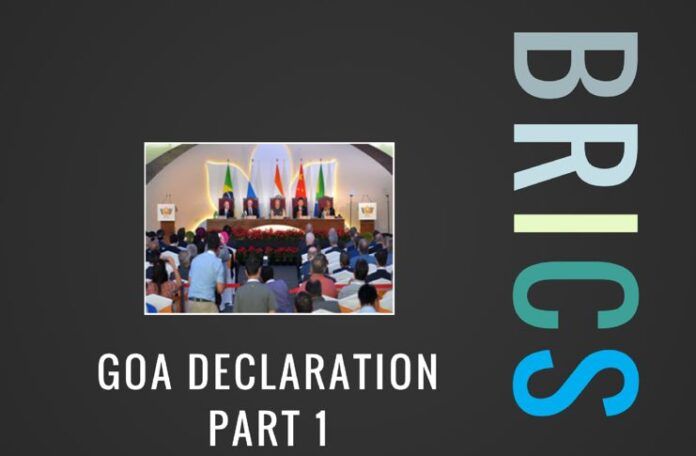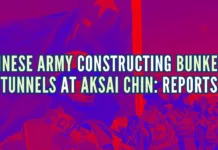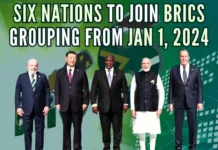
[dropcap color=”#008040″ boxed=”yes” boxed_radius=”8px” class=”” id=””]F[/dropcap]ive countries that make up BRICS, Brazil, Russia, India, China and South Africa, met for their eighth meeting on October 15-16, 2016, in Goa, India, and issued their findings in the Goa Declaration.
…BRICS try to improve the conditions of poorer nations through technology and management transfers.
Although all five countries are developing nations they perform an important function, as India did during the period of decolonization of the British Empire. India led several countries, especially African, to fight for independence through the 120-member Non-Aligned Movement (NAM). The BRICS meetings attempt to improve their own economic lot and solving their common differences.
Collectively, this organization coaxes the richer G7 countries to contribute even more than they do to the betterment of the world; more efficient outcomes can emerge, for instance, if international institutions like the UNSC and IMF were democratized by giving seats to India, Brazil and South Africa.
And, the BRICS try to improve the conditions of poorer nations through technology and management transfers. Soon after the Goa conference, for example, India met with six other nations, Bangladesh, Bhutan, Nepal, Sri Lanka Myanmar and Thailand for a Bay of Bengal Initiative for Multi-Sectoral Technical and Economic Cooperation (BIMSTEC).1 Issues like security, trade, and economic development were discussed. Pakistan would have been welcomed but for its perceived sponsorship of terrorism. The BRICS rightly claim that they are relatively minor agents working to fulfill UN’s 2030 Agenda for Sustainable Development.
[dropcap color=”#008040″ boxed=”yes” boxed_radius=”8px” class=”” id=””]T[/dropcap]he BRICS group would not have been as powerful as they are had it not been for Russia and China. Russia is a military powerhouse, in some ways more powerful than the USA. American generals acknowledge this advantage. China seems to be one of the few countries with a financial surplus, and its outreach programs in Africa outclass those of the Washington Consensus. China’s bi-lateral aid to Africa rose from $10 billion in 2000 to $198.4 billion, much greater than the contributions of the US and UK combined. China’s Foreign Direct Investment in Africa improved dramatically from $400.9 million in 2003 to $21 billion in 2012.2
…what do the 109 clauses of the Goa Declaration reveal?
With pressure from China, BRICS established the New Development bank with a working capital of $100 billion and a Contingent Reserve Arrangement (CRA) of another $100 billion, which is actively tapped for development.3 Besides, BRICS have a market of 40% of the world’s population, estimated at $16 trillion. Totten4 suggests, rather pessimistically, that the New Development Bank threatens the dollar. Maybe it might in the future, as today 66% of the IMF’s SDRs are still in dollars.
Given this context in which BRICS operates, what do the 109 clauses of the Goa Declaration reveal?
Russia’s interests were clearly manifested in this declaration: since it was under two sets of sanctions by the Washington Consensus, the condemnation of unilateral sanctions was a booster. So were other clauses which hit at external bullying: BRICS called for non-interference in the domestic affairs of states; no state should strengthen its security at the expense of others; common rules on equal rights, mutual respect and respect for each other’s interests should be observed.5
BRICS wanted WTO to be central to world trade. BRICS also wanted its energy program to synchronize with the December 2015 Paris Climate Agreement. The global goal was to bring down temperatures to less than 2 degrees Celsius above pre-industrial levels. The UNSC, IMF, and, by implication, all international institutions should be democratized at the managerial level.
Syria and Palestine also came under BRICS scrutiny. Syria had to be re-built by implementing UNSC Resolutions 2245 and 2268. Neighbor Palestine had to be regain its lost territory based on the 1967 borders.6
To be continued…
Bibliography
- IANS, “11 Heads of state, 800 delegates to kick off Goa BRICS meeting: official,” Panaji, September 13, 2016.
- FOCAC, “China in Africa: Devil or Angel?” FOCAC.org, 25.2.2014.
- Pepe Escobar, “A report from the annual BRICS meeting in India: their advance continues,” russiainsider.com, October 19, 2016.
- Jordan Totten, “BRICS’ New Development Bank threatens hegemony of US dollar,” forbes.com, December 22, 2014.
- Alexandrova Lyudmila, “Brics leaders adopt final declaration of Goa Summit,” tass.com, October 16, 2016.
- Alexei Drazhinin, “Leaders adopt Goa Declaration at eight summit,” sputnik.com, October 16, 2016.
- Part2 – China’s Road to Superpower status - July 20, 2017
- Part1 – China’s Road to Superpower status - July 18, 2017
- P2 – Can or should Qatar be ostracised? - June 29, 2017










